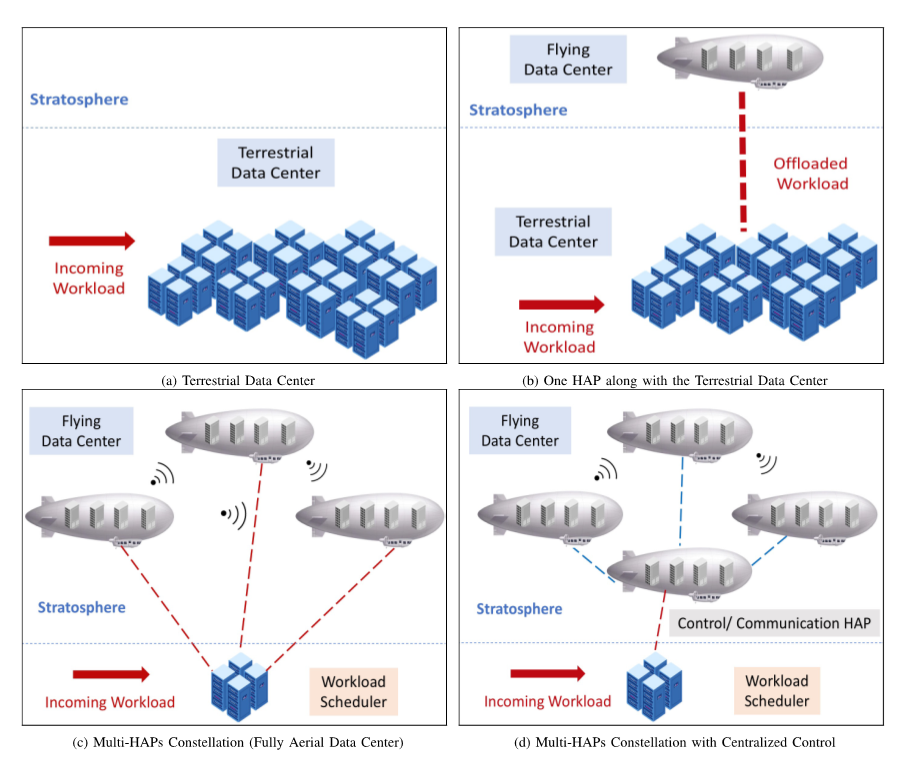Data center science fiction may have taken a step closer to reality after researchers outlined a new system featuring floating IT facilities that utilize the naturally low temperature in the stratosphere for cooling.
The data center industry is no stranger to utilizing innovative sustainability solutions. The planet’s natural environments have long been used as a means of increasing energy efficiency, from facilities being constructed in the cooler Nordic countries to those that take advantage of geothermal cooling from reservoirs – or even inactive mines – deep underground.
But what about flying data centers that could stay naturally cool in the stratosphere while harvesting solar energy? For a team of researchers at King Abdullah University of Science and Technology (KAUST) in Saudi Arabia, this futuristic concept might soon be within reach.
Data Center-Enabled High-Altitude Platforms
Published in September, ‘Data Center-Enabled High-Altitude Platforms: A Green Computing Alternative’(PDF) assesses the potential energy benefits of High-Altitude Platforms (HAPs), a conceptual data center system whereby servers are housed in a helium-filled, blimp-like airship.
According to the researchers from KAUST’s Computer, Electrical and Mathematical Sciences, and Engineering division, data center-enabled HAPs could realize huge energy efficiencies owing to the naturally low temperature in the stratosphere and their ability to harvest solar energy.
Rather than being a fully-fledged data center facility, the HAP would be electronically tethered to a more traditional data center on the ground. However, offloading just some of these terrestrial workloads to the flying data center could purportedly save up to 14% of energy requirements.
“We conducted an in-depth analysis of the operation of data center-enabled HAPs under practical and realistic conditions, examining aspects such as flying conditions, energy consumption models, harvested energy requirements, and the reliability of the transmission link,” explained KAUST researcher Osama Amin, who co-wrote the paper with Basem Shihada and Wiem Abderrahim.

A comparison of a terrestrial data center and different DC-HAP deployment scenarios
How Would HAPs Stay Afloat?
Explaining how a HAP facility would maintain buoyancy, Abderrahim told Data Center Knowledge: “Our data center-enabled HAP is filled with helium, like a traditional blimp. The HAP is supposed to have a fixed localization and it shouldn’t be moving. But, given the high speed of wind in the stratosphere, we need a propulsion movement against the drag effect of wind to stabilize the HAP.”
This propulsion energy would be serviced by solar energy generated during daytime and by the stored energy in the form of lithium-sulfur batteries or hydrogen fuel cells during night-time.
According to the researchers, the energy consumed by the HAP would be used for:
- Propulsion: This includes the energy required to localize and stabilize the HAP.
- Payload: This is the computational energy of the servers hosted in the HAP and depends on the server characteristics and the workload characteristics.
- Communication: This includes the energy utilized for wireless communication with terrestrial data centers. It covers the energy required to receive the offloaded workload from the terrestrial data centers, process it, and then send any required processed data back to the data centers.
Pi in the Sky?
It should be noted that this proposed solution is still very much a theoretical concept. The researchers themselves were quick to underline the numerous challenges that need to be overcome for high-altitude platform data centers to become a reality.
“The data center-enabled HAP faces two types of challenges, namely: technical and financial,” Amin told Data Center Knowledge. “From a technical perspective, the unfriendly weather conditions of the stratosphere necessitate the deployment of specially adapted and more resilient electronic devices. Additionally, the maintenance frequency of both the airship and the servers is crucial to balance the trade-off between the quality of the offered computing service and the HAP’s mission duration.”
Amin added: “From a financial perspective, the economic viability of the data center-enabled HAP should be considered. Capital expenditures such as the costs of the HAP platform and aerial servers, as well as operational expenditures like energy costs, must be factored into the overall assessment of profitability.”
Alan Howard, principal analyst at Omdia’s Cloud and Data Center Research Practice, told Data Center Knowledge: “Ignoring for a moment the technical and financial challenge of commercializing these high-altitude platforms, what’s compelling about this is that I could run a set of servers without having to pay for any power.
“There’s a long way to go before this remotely comes close to being something practical, but the whole notion of being able to run a data center with no cooling required and no grid power required is, fundamentally, an interesting concept.”
Helen Munro, head of environment and sustainability at UK data center specialist Pulsant, said: “It’s great to see innovative ideas that will challenge us to think differently about where we locate our data processing activities to be more sustainable.
“There is often still the need to keep processing local, particularly in low-latency applications. But in many cases, we should be pushing ourselves to think more about where – and when – we process and store data. In fact, we don’t have to go to the stratosphere – data centers in areas such as the Nordics are already benefiting from cooler conditions and low grid carbon intensity.
‘A Change of Mindset’
Notwithstanding the immense technical challenge of launching a floating data center up to 20km in the air (and keeping it there over an extended period), this latest research into high-altitude platforms comes as the data center industry faces an uphill battle when it comes to sustainability.
Data centers are now thought to account for around 1.5% of worldwide electricity use, and with the annual growth of the consumed energy by data centers expected to rise exponentially in the coming years, the need for fresh solutions is more important than ever.
“I believe that we will need to embrace a change of mindset that will facilitate a dynamic approach to both the location and the timing of suitable computing workloads,” Munro said. “Then we can get much smarter about how we consume IT power. It’s key to acknowledge that becoming completely sustainable will take decades of work and changes at a societal level, and collaboration with clients, suppliers, regulators, innovators, and our communities are hugely important in this journey.”
Looking ahead, the researchers said they will continue to refine their technical models and develop economic models for data center-enabled HAPs.
“Our ultimate aim is to contribute to the development of a viable, efficient, and sustainable solution for the growing demand for data center resources,” Amin told Data Center Knowledge. “We plan to move forward with developing a working proof-of-concept with the help of an industrial partner to demonstrate the feasibility of our models and provide practical insights into the operation of HAP-based data centers.”





